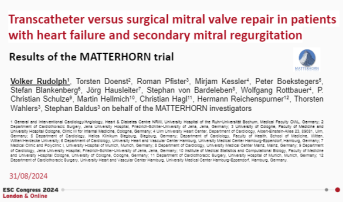MitraClip vs Surgery for Severe FMR? MATTERHORN Claims Noninferiority
Critics were quick to point out that this small, short-term trial—mostly in patients with preserved EF—had no medical arm.

LONDON, England—A small, long-running randomized trial suggests that transcatheter edge-to-edge repair (TEER) with the MitraClip (Abbott) can achieve similar outcomes to surgery in patients who have heart failure and functional mitral regurgitation (FMR), but a generous noninferiority margin and the lack of a medical control arm drew criticism.
Volker Rudolph, MD (Heart and Diabetes Center North Rhine-Westphalia, Germany), presented the 205-patient MATTERHORN results here at the European Society of Cardiology Congress 2024 immediately after the charged presentation of the RESHAPE-HF2 trial, which compared TEER to medical management.
“We conclude that among heart failure patients with secondary mitral regurgitation, mitral transcatheter edge-to-edge repair was noninferior to mitral valve surgery with regard to death, heart failure, rehospitalization, stroke, reintervention, or ventricular assist device implantation at 1 year, with a clearly favorable safety profile of the intervention versus surgery,” said Rudolph.
The notion of testing two invasive approaches in a population more typically managed medically, however, is a tough sell, according to cardiothoracic surgeon Joanna Chikwe, MD (Cedars-Sinai Medical Center, Los Angeles, CA), the scheduled discussant for the trial. “I am surrounded by what seems to be 5,000 evangelists for transcatheter edge-to-edge repair to treat a disease of the ventricle. And talking about doing it in moderate MR, when we haven't even agreed [on] the definition of severe MR,” she said.
MATTERHORN, with lead author Stephan Baldus, MD (University Hospital Cologne, Germany), was published simultaneously in the New England Journal of Medicine.
MATTERHORN RESULTS
MATTERHORN set out to enroll patients with FMR, defined by at least two echocardiographic criteria and a LVEF of 20% or greater, who were at high surgical risk for mitral repair or replacement and who had at least NYHA functional class II symptoms despite guideline-directed medical therapy. All patients had to have been hospitalized for heart failure at least twice in the year prior.
Ultimately, 72% of patients in the surgery group were treated with mitral valve repair, with just 28% getting a replacement valve and 14% receiving concomitant AF ablation. Among those treated with TEER, 49% of patients received just one device and 41% received two; nearly 3% of TEER patients required MV surgery.
We think these results may extend the indication for intervention in [patients] with secondary mitral regurgitation who are actually eligible for surgery. Volker Rudolph
At 1 year, at least one primary endpoint event—death, hospitalization for heart failure, mitral-valve reintervention, implantation of an assist device, or stroke—had occurred in 16.7% of the intervention group and in 22.5% of the surgery group (estimated mean difference -6%; 95% CI -17 to 6%), meeting the criteria for noninferiority in the trial. A primary safety endpoint event occurred in 14.9% in the intervention group and in 54.8% of the surgery group (estimated mean difference -40%; 95% CI -51 to -27%).
Residual mitral regurgitation grade of 0 or 1 was approximately 75% in the TEER group and 87% in the surgery group.
“In patients with heart failure with secondary mitral regurgitation, intervention with an edge-to-edge repair was noninferior to surgery regarding efficacy and has a much better safety profile,” Rudolph concluded. “We think these results may extend the indication for intervention in [patients] with secondary mitral regurgitation who are actually eligible for surgery.”
Some Grains of Salt
Rudolph acknowledged to TCTMD that 1 year of follow-up is not enough to understand whether surgery might look better over the longer run, and said that investigators hope to continue to follow patients.
Given the superior safety with the MitraClip and noninferiority for efficacy, “this confirms that in this often-elderly population, these results will have to be considered in the future when we treat these patients,” Rudolph said.
As for why the trial did not include a medical-therapy arm, Rudolph pointed to the fact that almost half of the cohort had an LVEF greater than 40%—a group with limited medical options, even more so back in 2015 when the trial kicked off. Surgery, he added, has a class I recommendation in this setting, but with a level of evidence C, in the European guidelines, making it an open question whether a transcatheter fix is a viable option.
I have been consistently impressed at how dynamic mitral regurgitation is and how you can improve symptoms with really aggressive optimal guideline-directed medical therapy. Joanna Chikwe
Chikwe, picking up on this point in her remarks, agreed that surgery has little evidence behind it: repairing a mitral valve is a long-shot approach for what is fundamentally a ventricular disease with very poor survival, as the 5-year COAPT data made clear.
“We’re not really changing prognosis,” she said. “The vast majority—more than 70 percent of the patients—are dead at 5 years, whatever you do to their leaflets.”
MATTERHORN itself had plenty of other design flaws, said Chikwe, pointing out that a noninferiority trial should have composite endpoints of the same clinical importance to both strategies and a common pathophysiology—something not seen here. The design was biased against surgery in other ways, too, most notably by including common, often transient, postoperative sequalae such as heart failure, revisions, and atrial fibrillation.
The choice of a noninferiority margin of 17.5% is also problematic, she continued. “I mean, really, if you had a medical treatment that had a 10% benefit in terms of, I don’t know, death or stroke, we wouldn’t want to use [17.5%] as a noninferiority margin.”
Loss to follow-up was “fairly significant” with five patients lost and 15 withdrawing consent. Fully 3% of TEER patients had crossed over to surgery within 12 months. The quality of the surgery, too, was widely variable, she said, noting the relatively low rates of replacement versus repair, reoperation rates of 8.5%, the 4% stroke rate in surgical patients, and the minority of patients with preoperative atrial fibrillation who received concomitant ablation.
Speaking with TCTMD after the session, Chikwe was still processing the seemingly positive reception of what she viewed as a short-term, flawed trial.
“You’re basically comparing two suboptimal treatments for a disease that’s primarily a disease of the ventricle, it’s not a disease of the leaflets,” she reiterated to TCTMD. “I have been consistently impressed at how dynamic mitral regurgitation is and how you can improve symptoms with really aggressive optimal guideline-directed medical therapy.”
Asked how often she’d done a mitral valve replacement or repair on a patient with heart failure and severe mitral regurgitation, Chikwe said: “I find it difficult to recall operating on a single patient for purely functional mitral regurgitation.” If she did so, “it would be a severely symptomatic patient, not a NYHA class II patient,” she added.
David Messika Zeitoun, MD, PhD (University of Ottawa, Canada), was also shaking his head. “There is no real standard of care group” in MATTERHORN, he said. “The standard of care should have been medical, and there is no medical group. They’ve just showed that when you do surgery if you don’t need it, you could die.”
Shelley Wood was the Editor-in-Chief of TCTMD and the Editorial Director at the Cardiovascular Research Foundation (CRF) from October 2015…
Read Full BioSources
Baldus S, Doenst T, Pfister R, et al. Transcatheter repair versus mitral-valve surgery for secondary mitral regurgitation. N Engl J Med. 2024;Epub ahead of print.
Disclosures
- Rudolph reports research grants from Abbott Vascular, Boston Scientific, and Edwards Lifesciences; consulting fees (to his institution) from Abbott Vascular and Edwards Lifesciences, and speakers honoraria from Abbott Vascular, AstraZeneca, Bristol Myers Squibb, and Edwards Lifesciences.
- Chikwe reports no relevant conflicts of interest.







Martin Bergmann